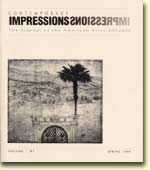|
 Contact Us | Site Index Contact Us | Site Index
 Home Home
 The Alliance The Alliance
 Exhibits Exhibits
 Gallery Gallery
 Resources Resources
 Library Library
 Journal Index Journal Index
 Book Review Index Book Review Index
 Print Study Rooms Print Study Rooms
  Glossary Glossary
 Standard Forms Standard Forms
 Workshops Workshops


 Subscribe Today! Subscribe Today!
|
Glossary of Print, Paper and Book Arts Techniques
To start, here is a simple glossary of Printmaking Techniques. These basic definitions are especially useful for general viewers and beginning collectors.
For much more complete dictionaries of terms, please scroll down to the links below.
- Relief prints
- Relief prints are printed from the inked surface of a block, usually carved wood or linoleum. Any cut-away lines or areas do not print. The ink is transferred to paper by rubbing the back of the sheet with a hand-held baren or by applying pressure with a printing press. Most collagraph plates – collages of objects and sculpture – are printed by relief.
- Intaglio prints
- Intaglio prints are printed from below the surface of incised or etched metal plates. Drypoint lines are scratched into the plate, while engraved lines are cut with a sharp burin. Mezzotint plates are roughened to print completely black except where burnished smooth. Etchings are made by drawing with a needle through the protective ground on a metal plate; when the plate is put into acid, the exposed metal is eaten away. An aquatint ground does not completely protect the plate from acid; when printed, the light and dark areas look like washes. For all intaglio prints, the recessed areas of the plate are filled with ink and the surface is wiped clean. The paper is dampened so that the printing press will force it into the depressions to pick up the ink.
- Screen printing
- Screen printing uses silk or other fabric stretched tightly over a frame. Images are created by blocking parts of the screen with stencils created by hand-drawn or photographic techniques. Ink is forced through the open areas of the screen onto paper or fabric.
- Lithography
- Lithography is a process based on the chemical principle that oil and water do not mix. Images are drawn on limestone or metal plates with crayons and inks which contain wax or oil. After treatment with gum arabic, the non-image areas become water-receptive. The stone or plate is wet before each inking with a roller, so the oil-base ink will adhere only to the image areas. Paper is pressed against the surface with a bar or roller press.
- Computer prints
- Computer Prints take advantage of innovative new technology including laser and inkjet printers. A digital document tells the computer printer which colors to spray onto the paper for each dot. Images can be drawn on an electronic tablet, scanned from drawings or photographs, or created mathematically and altered with software programs before printing.
Here are examples of terms from the complete glossary that we are working on.
- Lithotint
- A lithographic technique in which lithographic ink is diluted with varying amounts of water before it is painted onto the stone or plate to create the image. Undiluted, the oily ink saturates the stone, which would then print with a solid color; instead, lithotint washes do not fill the stone's pores and look very much like watercolor in the final print, even having a darker rim along the edges of the brushstroke.
- Soft ground
- An etching technique in which the plate is covered with a ground that does not completely harden. A sheet of paper is laid over the ground and drawn on with a pencil; when the paper is lifted, the ground sticks to it somewhat unevenly and leaves an exposed line in the plate which looks like a pencil line in the final print. Materials with different textures (fabric, paper, found objects) can also be pressed into the soft ground and lifted off, removing particles of the ground and exposing the plate to the acid so that it will quite accurately reproduce the texture of the material. Distinguished from "hard ground."
Additional resources on the web:
The best website for how to identify the various printmaking techniques, with excellent close-ups (called Image Maps) and a glossary, is the Print Room at the Spencer Museum of Art.
The National Gallery of Australia has posted the extensive glossary from Kenneth E. Tyler, Tyler Graphics: Catalogue Raisonné 1974-1985 (Walker Arts Center and Abbeville Press, New York 1987).
Animations demonstrating the basic printmaking techniques can be found at the website of the Museum of Modern Art (requires Flash 5 or higher). There's also a glossary and a reading list (be sure to scroll down).
The American Institute for Conservation of Historic and Artistic Works (AIC) has an Electronic Media Group with an excellent section specifically on identifying digital prints.
There's also a very good overview of printing, both for fine art and reproductions, part of an on-line exhibition on illustration, at the New York Public Library.
For book binding and book conservation terms, use the excellent online Dictionary of Descriptive Terminology by
Matt T. Roberts and Don Etherington.
|
![]() Home
Home![]() The Alliance
The Alliance![]() Exhibits
Exhibits![]() Gallery
Gallery![]() Resources
Resources![]() Library
Library ![]() Journal Index
Journal Index![]() Book Review Index
Book Review Index![]() Print Study Rooms
Print Study Rooms![]()
![]() Glossary
Glossary![]() Standard Forms
Standard Forms![]() Workshops
Workshops![]()
